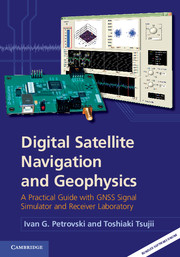 Digital Satellite Navigation and Geophysics
Digital Satellite Navigation and Geophysics Book contents
- Frontmatter
- Contents
- Foreword
- Preface
- 1 Methods of positioning with navigation satellites
- 2 Presentations and applications of GNSS orbits
- 3 GNSS signal generation in transmitters and simulators
- 4 Signal propagation throughthe atmosphere
- 5 Receiver RF front end
- 6 Real-time baseband processor on a PC
- 7 Multipath
- 8 Optimization of GNSS observables
- 9 Using observables in navigation-related tasks
- 10 Electromagnetic scintillation of GNSS signal
- 11 Geophysical measurements using GNSS signals
- 12 Aiding baseband and navigation processors using INS
- Next step – RF lab
- Index
- References
4 - Signal propagation throughthe atmosphere
Published online by Cambridge University Press: 05 March 2012
- Frontmatter
- Contents
- Foreword
- Preface
- 1 Methods of positioning with navigation satellites
- 2 Presentations and applications of GNSS orbits
- 3 GNSS signal generation in transmitters and simulators
- 4 Signal propagation throughthe atmosphere
- 5 Receiver RF front end
- 6 Real-time baseband processor on a PC
- 7 Multipath
- 8 Optimization of GNSS observables
- 9 Using observables in navigation-related tasks
- 10 Electromagnetic scintillation of GNSS signal
- 11 Geophysical measurements using GNSS signals
- 12 Aiding baseband and navigation processors using INS
- Next step – RF lab
- Index
- References
Summary
In the previous chapter we described how a GNSS signal is generated. In this chapter we consider how a GNSS signal propagates through the atmosphere. Figure 4.1 shows how this chapter is related to the book’s contents.
How a radio signal propagates through the Earth’s atmosphere to a great degree depends on the signal carrier frequency. We consider here a relatively narrow frequency range, which is allocated to various GNSSs. Figure 4.2 shows linear and logarithmic scales for signals with various wavelengths. It is possible to see the GNSS frequency allocation in relation to light, radio, and audio signals only on a logarithmic scale. Radiowaves, GNSS, and visible light are located relatively close to each other on a wavelength scale. This proximity between GNSS signals and light allows us to use most of the mathematical tools we use for optics for GNSS signal propagation.
A GNSS signal is affected by the atmosphere. It causes ray bending, signal delays, and frequency, amplitude and phase fluctuations. In this chapter we consider mostly systematic effects of the atmosphere on GNSS signals. In this respect most of the theory that has been developed to describe the behavior of light in the part of the electromagnetic spectrum visible to humans can be applied to GNSS signals.
Information
- Type
- Chapter
- Information
- Digital Satellite Navigation and GeophysicsA Practical Guide with GNSS Signal Simulator and Receiver Laboratory, pp. 104 - 126Publisher: Cambridge University PressPrint publication year: 2012